UPDATE – The seller has provided additional photos of the car. They have been added to the photo gallery below.
Post-war models from Packard always possessed presence, with their owners signaling to the world that they were a success. The brand was considered the height of luxury during this period and enjoyed strong sales. This 1949 Packard Super Deluxe Eight LWB 7-Passenger Sedan is a perfect example of the breed and would have attracted attention wherever its original owner went. It has fallen upon hard times, but it is complete. It would make an excellent hands-on restoration project, and returning it to its former glory would be no more difficult than for any classic from this era. The owner feels he doesn’t have the time to do it justice, so he has listed it exclusively at Barn Finds Auctions.
We sometimes have to look below the skin to understand why any classic is a prime restoration candidate. That is true with this Packard. Vehicles from this era are often consumed by rust, but the news is generally favorable with this Black beauty. The driver’s side front floor and rocker are rotted, with smaller sections in the trunk pan. However, the issues haven’t compromised the car’s structural integrity, meaning the winning bidder could fabricate replacement sections to return the body to a rust-free state. The underside has a consistent coating of surface corrosion, but once again, it is no worse than you might find on any classic from the 1940s. Externally, there is a dent in the passenger-side front door, but the remaining panels are straight. There might be the occasional bruise, but nothing justifying panel replacement. The glass looks good, and any trim that won’t respond to polish should sparkle following a trip to the platers. The trunk has additional parts, including a nice set of the often hard-to-find original hubcaps.
This Packard’s interior needs love, but it isn’t all bad news. It is complete, with vital components like seat frames and door cards present to provide the buyer with a starting point for a retrim. The headliner is shredded, but there appears to be enough material remaining that could serve as a template for a replacement. The winning bidder could continue to pursue the DIY path with the interior, particularly if they choose a retrim in cloth. Someone with well-developed sewing skills could stitch new upholstered items to minimize restoration costs. The bright trim pieces might require restoration, and the wheel will probably need specialist attention if a replacement can’t be found. The gauges are intact, with the markings crisp and the lenses surprisingly clear. The timber has aged, but with no significant splits or signs of rot, the buyer could restore those items with little effort.
This gem rolled out of the Packard Plant in Detroit, Michigan, powered by a 327ci straight-eight flathead engine that sent 150hp and 267 ft/lbs of torque to the road via a three-speed manual transmission. The beauty of this engine was that although the Packard weighs over 4,200 lbs, most of the eight’s power and torque occur low in the rev range. That allows these cars to pull strongly from low speeds in surprisingly high gears. It adds a level of flexibility that makes the driving experience reasonably effortless. The owner says the motor turns freely, but he hasn’t tried to coax it back to life. It requires a thorough inspection first, but the indications are it may not take much effort for it to roar into life once again.
People sometimes look at me strangely when I say cars like this Packard Super Deluxe Eight LWB Sedan make ideal projects for enthusiasts with DIY blood coursing through their veins. However, they fall into that category for a simple reason; These classics are primarily hand-built, with machines having little to do with their production or assembly. Therefore, anything assembled by the human hand can be disassembled by the same means. This is a giant of a car, but the indications are that its restoration could be relatively straightforward. So, if you’ve harbored a desire to own a car produced by one of America’s great prestige marques, bidding on this Packard could be the ideal first step in your quest.
- Location: China Grove, North Carolina
- Mileage: 75,041 Shown, TMU
- Engine: 327ci Straight Eight
- Transmission: Manual
- VIN: 2271-9-3011
- Title Status: Missing
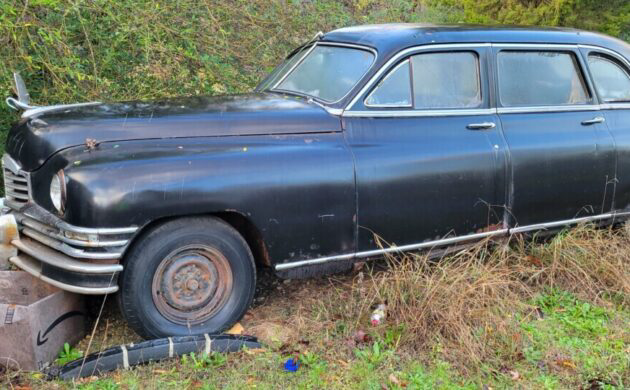



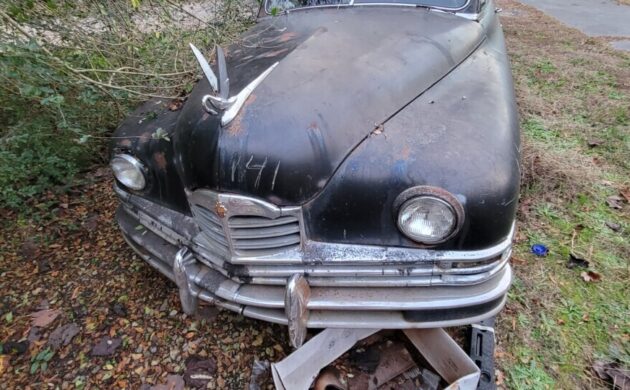
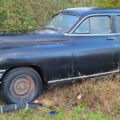
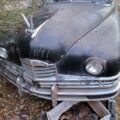
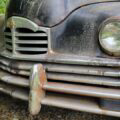
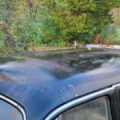
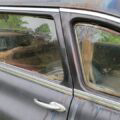

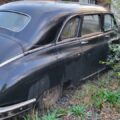
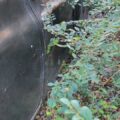
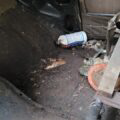
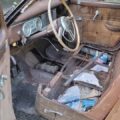
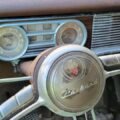

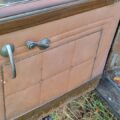
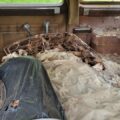
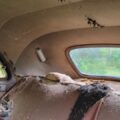
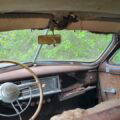
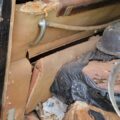
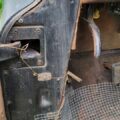
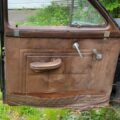
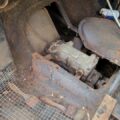

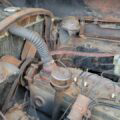
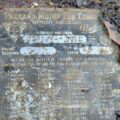
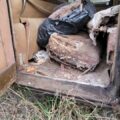


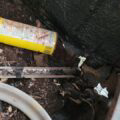

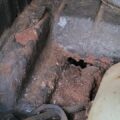
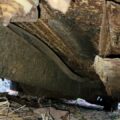


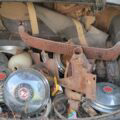


Funeral limo?
This limo was likely built by the Henney Company in Freeport Illinois, using the Packard professional/commercial chassis. Henney had an exclusive agreement with Packard, being the only company allowed to build professional vehicles on the Packard commercial chassis. ALL Packard based professional cars (hearses, ambulances, flower cars, service cars, limousines) were built by the Henney company. Unfortunately, Henney went out of business along with Packard. At one time, Henney was part of the “big four” professional car companies Superior Coach, the Miller-Meteor division of Wayne Corporation, Eureka, and of course Henney. The other three companies built mostly on the Cadillac commercial chassis, but Superior also built on Pontiac chassis, Cotner-Bevington (also a Wayne Corporation company) built on Oldsmobile, Flxible built on Buick, and various other much smaller companies built on pretty much any chassis the customer desired (and procured). Other than the Packard and Cadillac professional cars, the smaller coach companies would generally split and then lengthen a regular sedan, and then build the body largely by hand, and mount it onto the professionally lengthened chassis.
I see you mentioned Henney, which was actually Henney Buggy Co. I have family roots which began in Freeport, love to chat with you
This Packard and those of the late 40s were not a good looking car. I love the Packard, but not this series.
This is also going to be quite a project, so good look to whomever tackles it.
Honestly if it was me I would scrap it so its probably a good thing its 2500+/- miles away
I thought i saw this car come up before. Someone bought a lot of cars, kept the good ones and offed the clunkers. Would never be worth what it would cost to restore, even DIY!
This car was sold at an auction in upstate New York last year, see my comment below for more info.
For me It’s only 45 miles away. I’m a BIG fan of this series. “Bathtubs”.
But I don’t see it as a 1500.00 or so purchase.
I see it as 70K of restoration. I have neither the time nor the money.
What extended wheelbase pickup chassis would slide under this and donate its drivetrain etc. to this patrician lord?
No bids??,,the freakin’ Cormorant is worth $300 alone. Oh mercy, sadly, it’s all I see of value here. When we restored our 1950 Standard 8, we accumulated 3 parts cars, 2 I bought ( for $300) just for the visor. This would have been a great parts car, but to restore it is for the ambitious, or in need of some very useful parts. Nobody I know reproduces front fenders. Mine was an automatic, and one of the parts cars had an automatic cobbled in a stick shift car, common at the time, but a limited audience here, heck, it was limited 30 years ago. For a 22nd series Packard nut, this is a goldmine.
My Father was A Packard dealer when these were new, I remember them because in order to get other Packard to sell he had to take these. I have no idea why Packard had so many of them, but I remember my Dad, would pack an overnight bag, and start off to see any Funeral director, and show them, and a lot of times when he came back, it was in an older car that one of them had. Would love to have one of them but no way at 89, I’m way to old to restore one. Some had a window in back of the front seat, and had a buzzer system to talk to the driver. They were fabulous cars, and a treat to drive. I drove one of these, and took General Albert Watsons, Mother in-law to Governors Island, and to General Eisenhower farm, in Gettysburg Pa. Many great memories of that 1950 Packard RIP General, you were a great man.
I’m always fascinated how many funeral coaches and limos are sold annually. You’d think the market would be flooded, as many as they’ve made over the years.
We have a 49 Senior 8 that was sold new to a local funeral home. Just a black sedan, not a limo, and it has the overdrive 3 speed trans – not even an automatic. It’s pretty frugal for a funeral parlor!
Too many surprises with an old Jalopy that’s been sitting around for years. 50 years ago I was disappointed when the ‘48 Packard engine block I was rebuilding couldn’t be bored. Casting shift in manufacturing process was to blame. Quality control wasn’t great for this late vintage Packard.
GT,
I’ve owned hundreds of Packards and worked on many, many more, and have never found any casting defects in iron, aluminum, brass or zamac castings. Packard’s quality control was well above average until the 1955 series cars when they made a mistake and moved the assembly line to a much too small facility.
Professional cars, engineered and built by only a handful of companies, are extremely rare as compared to “retail” cars built for the masses. In many cases, especially in small towns up until the early 70s, these cars served double duty as the funeral home often times also provided the only ambulance service for the town. During funerals, it served as their front-line hearse but the rest of the time, it was easily and quickly converted to an emergency ambulance. These cars were known as “combination cars”, and they had a demountable red roof beacon, an under hood mechanical siren, they could insert a plastic “AMBULANCE” sign in the rear side windows, and they could flip the floor in back as it had rollers and bier pins on one side, and a flat floor for ambulance use. It also had 2 jump seats on the ambulance side of the floor, for the attendant and perhaps a family member of the patient. Of course it also included a stretcher, which served double duty as an ambulance stretcher, but it was also used for removals of deceased people from their place of death back to the funeral home for embalming and preparation for burial. Bigger towns and cities often times had professional built ambulances, which were also built on to the Cadillac or Packard professional chassis. In those cases the local funeral homes usually had special built hearse only cars which could either be a side-loading car, rear loading, and even three-way hearses where you could either load/unload the casket from the rear, or even from both sides of the car due to an automated, electric, or manual table. The ambulances were almost always total work horses, and would be driven until the wheels were about to fall off. Over the years, as these cars were eventually replaced by our current crop of ambulances, in either the modular truck or van based ambulances, and van type ambulances now becoming more popular on the transit van type. These old professional cars were usually traded in for a newer model, and were even sold used to the next customer, and over the years they usually rotted away in an old funeral home’s garage, in a back lot of a used car dealership, or purchased by various customers. In some cases these cars are restored, and treasured masterpieces by professional car buffs, and in many other cases they are purchased with the goal of turning it into a resto-modded hot rod, gothic type muscle car, and in some cases people even try to turn them into custom made SUVs with 2 to 4 row seats, lift kits, and oversized tires. The mere rarity of these cars makes them loved and treasured by a great many demographics, while others find them morbid, odd, or dumb. In almost all cases, they are VERY expensive to work on and maintain, as parts are next to impossible to find most of the time, not to mention quite expensive.
I restored a regular 23rd series four door sedan and was lucky to get my money out of it but only just. My experience lead me to vow I’d never restore another four door hardtop.
Straight 8 sure liked there fuel
I’ve never met an internal combustion engine yet that didn’t like it’s fuel. I guess maybe 50 years from now, people will be saying, damn, those electric motors sure did like their electricity. Geez
When I was around 17 or 18 I had that hood ornament. It was pitted, and my father painted it silver but I was going to use it on one of my later Buicks or Cadillacs. Never knew what happened to the darn thing.
They had 3 hood ornaments. The stock one was called “Goddess of Speed”, but most of us called it “Boy with a Doughnut”. Optional was a Cormorant (not a swan, not a goose, a CORMORANT!), I think it cost about $5. Then they had an gold and glass one we called the Egyptian, cost about $7. Saw one new in the box sell for $800 on eBay a couple of years ago…woulda been sold to me if I’d seen the auction sooner!
Unless a labor of love, I don’t see how one would ever get their money back from the amount of work required. I personally like the look of this limo and could see some company resto-modding it as a limo in service with a modern drive train. Beyond that, unless some museum wants it, it’s a hard sell.
Formerly from the Abelove collection, sold in 2021 for $750 plus commission. Was stored inside for years prior to sale.
Saw an offering on CL a couple of years back for a trio of these in NM that if your were cautious you could have built one from the three (actually one of the three was a sedan but it had all the good chrome). For $800 for all three I was mighty tempted. But it stopped there….tempted….
There were no 23rd series hardtops. Btw: the 23rd series was built in the last half of 1949, and all of 1950. The 22nd series was built in all of 1948, and the 1st half of 1949.
Why does this 1949 Packard not have the upper level grill and side trim? It is listed as the upper level model?
Because it is a 1949 22nd series. The 23rd series had the upper belt stainless.
Tom,
This is a rare Super Deluxe LWB sedan known as the Business Sedan, model 2271-9. The limo version was the Business Limo, 2270-9. The one you are asking about was the bit Custom Eight Packard which had the “Egg crate” center grill and twin side chrome strips. For the 23rd series the side strip was moved to the center of the body sides.
I’ve got a 23rd series standard with Ultramatic that’s at the paint shop having a scrape on the side redone where I let it slide off my lift and hit a vertical support. Kanter Brothers and Max Merit do a good job of supplying parts for them. They are easy to work on, but unfortunately aren’t very popular…I guess because by today’s standards they’re butt ugly! I shudder to think what it’d cost to resurrect this car! You’d have to do it for the love of the car, not to make a profit.
When I was younger I thought the inverted bathtub design was terrible…and maybe it was a factor in Packard’s slow demise…But they sold a lot during that period too – roughly 90,000 in 1949, compared to 1.2mm ford cars for example. But the design has really grown on me over the years. It’s very modern and bold for the era, yet was quickly dated as the ’49 Chevy and Ford models debuted.
I used to refer to my 23rd series as a 356 Porsche on steroids.
In 1948 there were 8 major styling awards for various types of products. The Museum Of Modern Art [MOMA] in New York awarded a first prize to all 8 [info from a 1948 Packard magazine ad]. MOMA actually had a 1948 Packard Super 8 convertible on display in connection to the awards. Packard was also awarded the ‘Fashion Car of the Year’ gold medal by the New York Fashion Academy.
The problem was the rapidly changing postwar automobile designs made the slab-sided cars like the Kaiser, Frazer, Ford “shoebox” designs, and especially Packard, look obsolete within only a few years.
By the 1960s the “Bathtub” Packards were often blamed for the company’s demise, because the actual multiple causes for Packard to cease as a car manufacturer were shrounded in mystery until recently.
To discover what really happened, Read Stuart Blond’s new book “Spellbinder” about Studebaker-Packard thru the eyes and writings of James J. Nance, the last Packard President. His 2-volumn book delves deeply into the facts behind the closing of the Packard Detroit factory, and the move to South Bend.
“Vehicles from this era are often consumed by rust ” That’s not too surprising , as they are nearly 75 years old – most of the surviving cars that have sat for decades obviously would have rust issues
That would depend on where they sat. Long list of variables, inside, or outside, dry climate, or humid climate, the list goes on.
Totally agree ; its just that this statement seems to get posted a lot . “50s cars are often , 60s cars are often ,” etc.. It does depend on the area , and what kind of car as well – you could have a 71 Vega and a 71 Lesabre sitting right next to each other for years; which one would be rusted to pieces ?
Always loved the old Packards and Hudsons of late 40’s early 50’s. I would kill for a mid to late 30’s Packard with a rumble seat. Saw one locally in teal blue that was in perfect condition; couldn’t take my eyes off it.
This 49 Packard is a similar syle to the 54 Cadillac Fleetwood for sale on auction here on BF. Although you can appreciate the craftsmanship involved in hand building these cars,their models and styles are just not very desirable or collectible. Maybe Packard and Cadillac car clubs should start a go fund me type way of doing something to save them. Certainly value left of their engines and drivetrain.
One of the interesting things about the 22 & 23rd series Packards (and other series too, probably) is that to our modern eyes the different models look pretty much the same. But the more expensive models took about twice as long to build because their tolerances and craftsmanship was much better.
You mean to tell me that people don’t restore a car or pickup out of love for the car? That they do it for profit?
I’m sorry Mr. Davis, I should not joke about it. I know I would be on to do for the love of the car. If I could afford to have 8 or 9 classic cars (which will never happen on my Social Security check!) then maybe I could see selling for profit. But I would be ecstatic if I found a ’65 or ’66 GTO it would always be for love. Thanks for bringing it up H.D. I meant no harm. 😉
Neal, I’ve said for years that there are two kinds of old car people…those who do ’em for the cars, and those who do ’em for the money. Not to say those who do ’em for the money can’t love ’em too, but it’s not their primary focus. I’ve very lucky in that I’m 78 and still working for a paycheck, so that social security check is my “car play money”. My wife says when it comes to cars, I’m just a consumer, I love ’em all, but mostly the odd ones.
Hey everyone, Seller here! If you have any questions about this or want any specific details about certain parts of the car I can do my best to answer them. I did go on a bit of a wild hare in the past week and rebuild the carb and pull the spark plugs, but haven’t gotten too far into the “attempt to make it run” weeds yet.
AR- The issues I had with my 23rd series running were the fuel pump sucking air and the cloth wrapped wiring harness. Best of luck to you.
Boy, I wish I could use my S.S. money for car money. This is probably why I am only dreaming of a GTO instead of driving one. I am 69 but at this point I am starting to see my dream fall apart. I am too old to a restore and paying for someone to do it is not in the books. That leaves me with one option and that is to pay $50 or 60 thousand for one. Looks like all I can do is dream at those prices.
This is a very rare vehicle, known as a model 2271-9 Super Deluxe 7-passenger Business Sedan. The website packardinfo.com says total production was 960 vehicles, and only 2 are known to exist today. I don’t know if the listing was updated to include this car, so it’s possible the known survival rate may have increased by 50% to a total of 3!
I’m pretty sure this limo was part of the huge Packard vehicle hoard in upstate New York, sold by Collar City Auction Co last year. I’ve owned several hundred Packards over the years, and have had quite a few Packard limousines and LWB sedans [I like them!], but never had one of these, and I don’t remember ever seeing one IRL.
For years these Super Deluxe LWB cars were of little interest to Packard collectors, with the big Custom Eight versions in high demand. Today there is some increased interest in these, as so few survive. The Super Deluxe was a mid-level example, with the Custom Eight at the top, and the Super 8 at the bottom of the LWB sedans. The only difference between the Super and the Super Deluxe was the interior – it had the more expensive wool broadcloth and leather seats & door panels, that were standard in the Custom Eight cars. The Super Deluxe also had the Cormorant hood ornament [as shown on this car] and wheel trim rings as standard equipment.
Most of the Super LWB sedans were sold to businesses that needed to transport 7 people in relative luxury [like hotels], and Super Deluxe LWB sedans were mostly sold to Funeral homes, and a few LWB cars of both versions were sold to higher income buyers with larger families.
The Super Deluxe LWB cars were fairly under powered compared to the Custom Eight with the 9-main bearing 356 straight 8. This car does not appear to have overdrive, so I suspect it was a funeral car.
This car needs to find a motivated buyer who will make the effort to bring it back to life. The front floors and rocker panels [in shorter lengths] can be sourced from rust free regular Packard sedan parts cars. All of the mechanical parts are available either new or used. While some of the chrome trim pieces are getting hard to find as NOS parts, most trim is also available. The correct interior materials are also available except for the carpeting. The first thing I would do if I bought this car, would be to buy the necessary parts to install the original Borg-Warner overdrive transmission.
You’ve owned “several hundred Packards”? Ok.
Yblocker,
Several hundred? Yeah probably at least that number [spread over 50+ years]. I bought my first couple of Packards while still in high school. I operated a restoration/repair shop for decades and specialized in Packards. The estimate also includes parts cars. I bought a lot of postwar Packards in the 1970s-80s on the cheap to part out, and I was a Packard parts supplier [NOS and used]. I was one of the Packard parts guys in the Packard building [now gone] at the Carlisle, PA flea market. When I retired there was over 250 vintage vehicles out back of my shop, in what we called the junkyard, and there were probably at least 30 Packard parts cars that I auctioned off.
So yeah, at least a couple of hundred, maybe more!
I can think of 40+ cars that I have owned just off the top of my head (I probably missed a few)- I often had 10 or more of all types at a time, and I wasn’t even trying…
Perhaps it was easier “back in the day”.
Bill McCloskey,
I wish I could send you pictures of a 1936 Packard phaeton. I cannot tell if it is a 120 or a Super 8. I suspect that there will be higher value if it is a Super 8. I have it available to me for a very, very low price. Owner has passed and son lives some distance away and wants to clear out the house and the garage on just one visit in two weeks It is that famous yellow color with a tan interior and tan conv. top/ It does have wind up windows. Appreciate any tips you have for me. The price it is being offered to me is $15,000.00 as is. Front suspension needs to be reassembled. I sure wish to obtain your opinion
Tom, the easiest way to determine if it’s a 120 or a senior Packard, is the front axle. If it’s an independent coil and the upper control arm is part of the hydraulic shock absorber, it’s a 120. If it’s a straight beam front axle, it’s a senior car.
@Bill McCoskey – were you ever down at the Dayton Packard museum in the late 90s or 2000s? I think we may have met. I worked in their restoration shop back then
SG,
I must admit I’ve never been to the Dayton museum, but I do happen to be planning on a visit to Dayton this summer for both the Packard and the Air Force museums. I’ve been to many PAC national meets from 1968 and up, and I’ve been to the Packard museums in Warren OH & Ft. Lauderdale, FL, but so far Dayton has eluded my presence!
Bill, the Packard museum in Dayton is interesting, and being a dyed in the wool Packard guy you’ll probably enjoy it more than most. But the Air Force Museum is the best aviation museum on the Planet! I grew up with airplanes like a farm kid grows up with tractors, andI’ve been to just about all such museums in the US and dozen’s around the world, and none can hold a candle to Wright-Pat. If you’re a real “airplane guy” it’ll take you more than a day…”blind dog in a meat house”!
Henry,
I’ve been to the both of the Smithsonian’s museums many times; Air & Space & the Udvar-Hazy, and as I live so close, also the storage facilities. About 40 years ago I had a private tour of the storage building in Morningside, MD, where the Enola Gay was sat in pieces, and I was actually allowed to go inside it’s empty cockpit.
I’ve also spent many visits at the Imperial War museum in Duxford, Hendon outside of London, and the huge museums in Germany: Sinsheim and Speyer. And not to forget the aviation museum at Le Bourget outside Paris.
about 35 years ago, while at Duxford, I was watching several WW2 fighters doing touch & go, and on landing I spoke with the pilot of a P-51 Mustang trainer [this was back when anyone could walk out onto the grass field]. I had mentioned it was one of my dreams to go up in a Mustang, and he asked me if I flew, so I said, I had indeed piloted a plane; specifically a Skyhawk.
He indicated he was taking a break to check over the plane, but If I waited a bit, he would take me up! He did exactly that, and on returning to the grass field, he asked me what it was like to pilot a Skyhawk, something he had always wanted to do.
To make the story short, He thought I was talking about the Douglas A-4 fighter known as the Skyhawk, and I was referring to the Cessna 174 Skyhawk! But that simple misunderstanding DID get me up in a P-51!
If Dayton is superior to the places I’ve visited, it will probably be one of the year’s highlites!
Bill, since you’re kind of an airplane guy, I assure you that you’ll enjoy Dayton more. Smithsonian has historically famous airplanes, but is aimed more at the history enthusiast than the airplane nut. I lived in Memphis for years, and helped overhaul #3 engine on the Memphis Belle while I was going to A&P school. Hands on teaches much more than books or museums ever can. And even given the storage facilities at BWI, Air Force Museum has many more planes on exhibit. And…as an old Navy pilot…I’ve gotta say Pensacola is in a poor third place in the museum sweepstakes! And how did we get sidetracked on this when we’re supposed to be talking about Packards? Maybe mention V-1650s?
Henry,
My girlfriends and I love everything to do with vintage transportation; trucks, steam trains and aircraft, but especially cars. So when I’m involved with a conversation, it often shifts from one category to another.
Bill: What is your thinking on the value of both models please, ( 120 and Senior). Might you be interested at a price around $15,000.00?
It sits with the front suspension disassembled. I have some 12 pictures of the car but not this area of the car.
Tom,
Unlike more common cars like Chevrolet and Ford, Packards are not easy to throw average values aound, especially open cars. First we need to know if it’s an actual Phaeton, or a convertible sedan. Both can be quite valuable, but the phaeton may be much more.
I would love to own such a car at $15k, but I’m too old to even consider another project, I’m selling off a lot of my various collections as it is. I would be willing to advise as to what you have if you want to send photos to billmccoskey(at)aol[dot]com.
@ Henry Davis
What the hell is a Cormorant?
Whatever it is, I had one, 😄
Cormorant is a diving bird. sometimes called a Sea Raven Saw a video once…from Southeast Asia or India I think…of them being used for fishing. Fishermen would catch one, put a metal ring around their neck so they could only swallow small fish. Attach a fishing line to the ring, and reel ’em in after they caught a fish too big to swallow. Would then put ’em in a cage, take off the ring, and feed ’em a fish or two until next time.
Henry Davis,
You answered Angel’s question from a scientific standpoint, and you’re 100% spot-on. Now I’ll attempt to connect the story of how the Packard bird got the Cormorant name.
The original bird was part of the Packard family crest, adopted as the corporate emblem as well. At the top of the crest is what has been described in heraldic terms as “A pelican in it’s Piety” [In lay terms a bird feeding it’s hungry chicks by plucking it’s own breast for them to feed upon].
As I recall, the Pelican hood ornament first came out as an option for the 1933 Packard. The west coast Packard distributor was Mr. Earl C. Anthony, and Cormorants were found along the Pacific coast. Rather than refer to the bird as a Pelican, Anthony’s companies began calling the ornament by the more dignified name “Cormorant”, and the name stuck.
Forgot to include a copy of the Packard crest showing the Pelican and it’s brood at the top.
Thanks Bill…You know some sh*t !!
Yes he does! Especially Packard, and other makes. I’ve had the pleasure of talking to Bill through email and he has some very interesting stories. He’s worth getting to know, share experiences of the hobby and I consider him a friend.
Bill does seem like the go to guy when it comes to Packards. He’s had alot of experience working with and restoring them.
I’ve heard these Packards referred to as “bathtub” models. Nash has the corner on upside-down bathtubs, I think. These Packards, the ’49 & ’50s somehow remind me of elephants, don’t ask me why, but every time I look at the front of it I just think elephant. The body looks bloated like an elephant, also.
Those of us who just dabble with old cars are in awe of those who have given their entire existence To them, mostly to just one make. Very humbling!
A good DIYer with good MiG skills could restore this thing to solid and mechanically functional condition without spending much money. I doubt that anyone would want to restore it to concours condition, though. If closer inspection revealed no cracks in the block from freezing and a complete and relatively intact drivetrain, it could be running in an afternoon.
With great Packard engineering involved, it probably wouldn’t take much to get this one starting, running and stopping again. You could always wait and do body and paint and interior later. This kind of project would keep a teenager or middle aged man out of trouble for sure.
Only if the girlfriend or wife never sees the checkbook…
In the summer of 1976 I found a 1948 Packard Custom Super 8 limousine sitting in a storage lot in Hyttsville, MD, just a mile north of the DC line. I bought the limo for $100 cash. It had 1965 license plates, so it had sat for about a dozen years. It’s overall condition was similar to this Super Deluxe LWB sedan featured here.
My friend Richard helped me get the car going again, we replaced the radiator hoses, engine oil & filter, filled the radiator with water, drained the old gas out of the tank & put fresh fuel in it, and with a new 6 volt size EE-3 battery, it wasn’t long before we had the engine running.
All 4 tires were still holding air [thanks to the car having inner tubes!], so after bleeding the brakes, and on one of the hottest days in August, we elected to drive the big Packard from Hyattsville to a Packard Club local meet in York, PA the next weekend! We did fill the trunk with a nice assortment of tools, and plenty of extra fluids. Also set 2 more good spare tires on the rear compartment floor just in case!
That Packard performed perfectly on the almost 200 mile trip up and back down to where I was going to keep it in Rockville, MD. Never came even close to overheating [that can’t be said for the 2 of us, as it was approaching 100f that afternoon!].
I ended up selling that big car to a Packard collector, and shipping it to him in Minnesota. I had warned him it was a bit rusty, but on getting the car he wrote back to say compared to what old cars look like in Minnesota, it wasn’t badly rusted at all!
Kurt, your comment about the wife/girlfriend reminded me of a restoration we did on a 1968 Roadrunner hardtop about 20 years ago. The owner was fairly well-off financially, and owned a large trucking company. Because his wife would always complain about how much he was charged for the restorations and repairs to his cars and old trucks, He asked me to prepare 2 sets of monthly reports and bills.
One set of repair listings with the amounts owed for parts & labor was sent to his home, and he would pay with a personal check. The other set of repair work & parts listings was sent to his office, and this second bill, always much more expensive, he paid from the trucking company’s accounts.
As far as I know, she never found out, and years later when I was talking with another local restorer, on finding out my shop had done work to one of the guy’s vehicles, he asked me if I did a double billing system for the work on the Roadrunner!
I saw the Bill Harrah’s collection in Sparks, Nevada. He had one warehouse just for his collection of Paackards and he had every year in secession one after the other for every year. Not a year was missing. I saw it in 1970. My grandfather would not switch from Pacckard to another brand like his brothers did. He had one of his sons maintain an inventory of 1955 & 1956 parts so he could keep driving his 1956 Patrician. There were three truckloads of parts when this house was liquidated. This was in Lake Milton, Ohio
I went through that museum about 10 years ago, can’t recall a Packard collection.
Every time I hear a 56 Packard Patrician mentioned, I think of Charles Starkweather lol
Yblocker,
The National Motor Museum collection you visited 10 years ago was but a VERY small remnant of the original Harrah’s collection. Mr. Harrah was a Packard guy who was trying to put together what was at the time the largest collection of Packards anywhere. He was actively buying examples of various types of Packards right up until his death.
Back then I owned what was the only known example of a 22nd series Packard Six Taxicab [2286 body style]*. The 1948/49 22nd series was the last 6 cylinder car made by Packard, and Harrah wanted one. The Harrah museum had contacted me several times asking if the Taxi was for sale, and in 1978 a friend and I visited the museum to discuss the possible sale. However on our arrival we discovered Mr. Harrah had died a couple of weeks earlier, so they were not buying anything at that point.
* Over the subsequent years 3 more examples of a 22nd series Packard 6 have been discovered, one is in Europe, 2 others are in the USA and are also Taxicabs, one of those is a LWB New York City Taxicab.
Bill, That is a most interesting story. I highly enjoy reading reading what you say about automobiles. Thank You.
I have the following information about Packards. A 1928 model 443 for sale near Bakersfield, Ca. Restored and well cared for. Owner is now over 86 and he is finally getting ready to sell. He has a 1955 also that is in my price range and I want to get it soon. I keep looking for a comment from you about the 1936 Packard phaeton that I do not know if it is a 120 or a Super 8. A fellow I sit with and talk about old cars has a 1940 Packard model 120 touring that has been in his garage for 60 years, burgandy/black In his family since new.
There’s really only two cars that stick out in my mind from that visit, one was a 57 Lincoln Mark II, with a Hemi, which I believe was one of Mr Harrah’s personal cars, the other was a 1917 or so, Chevrolet V8.
There also used to be a beautiful auto collection at the Imperial Palace on the strip in Las Vegas, but it’s gone now.
Tom, as I pointed out elsewhere in this thread, the easiest way to determine if the 1936 car is a 120 or a Super 8 is the front suspension. If it has independent front lower control arms with a coil spring, and the top A-arm is also the hydraulic shock absorber, it’s a 120. If it has a solid forged beam axle, it’s a Super 8.
To identify it further I would need the info on the VIN plate, located on the firewall in front of the driver, or photos of the hood louvers and/or the full dashboard.
If it’s a 120, the VIN should be a stamped 3 digit number beginning with 99, followed by a hyphen, then a 4 or 5 digit production number. For example, a 120-B convertible sedan would be stamped 997-XXXXX. A 120-B 4 door is a model 992.
If it’s a Super 8, the VIN should be a stamped 4 digit series/body number followed by a hyphen, then a 4 or 5 digit production number. It’s the first 4 digits that tell me what year and model the car is. If it’s a 1936, it should start with 14, and the other 2 digits will be 00 to 08. For example, a 1401 can be a Eight Sport Phaeton. A 1408 is a Packard 12.
That said, some of the Senior car serial number plates don’t display the 14XX number, and instead display the body style number. These are 3 digit numbers that start with 901 to 973. For example, a 901 number indicates an Eight Sport Phaeton.
The exception to this rule is the cars with LeBaron bodies, they start with the number 2. For example a car with 294 would be a Super Eight with a Labaron all weather town car body.
So as you can see, when it comes to the senior cars, the VIN data plate can be confusing, as the selling dealer stamped the info into the data plate prior to placing the car for sale. Some dealers used the 14 series number, some the 3 digit 9XX number.
The 1928, if a closed car, will be difficult to sell, especially if it has 4 doors. Like many of the pre-1930 car makes, closed sedans have been losing values in recent years.
As for the 1955, do you know if it’s a Clipper or a senior Packard, and what body style [sedan, hardtop, or convertible]?
The 1940 Packard 120 sedan is a great driving car, and if indeed a 1-owner and mostly original car, is worth adding to any Packard collection.
Bill, Goingto take advantage of you one more time please…
Does the 1955/56 Clipper and Patrician have the same body dimensions?
I have two extra windshields. I am thinking they should fit both models.
The Patrician is on a 127″ wheelbase, while the Clipper and ’56 Executive are on a 122″ wheelbase. Windshields are the same. If the glass is tinted [Marked Solex if original] they should be boxed and saved. Side and rear glass is the same except the Senior Packard rear windows were changed for 1956, the change is at the lower corners.
This assumes the windshields are not for [or from] a Caribbean convertible, those were carefully cut down across the top by 2″, and are very valuable.
Which Packard or Clipper do you have?
I have two Patricians. One is black and the other is rose and cream.
I have two 55 Super Panamas. One is very rusty, the other is just rusty.
Henry,
A lady friend I knew in high school inherited an all black ’55 Panama from a grandparent, and she used to drive it to high school with the torsion level jacked up in the back, and the power switch turned off.
She told me one time a cop had pulled her over for having the rear bumper up too high, but she had turned the power switch back on as he was talking with her, and once it was back down she put on a “little innocent girl pout” and said “Officer, whatever do you mean?”
The V8 Clipper hardtops are my favorite of all the post-war Clippers. I happen to like both the ’55 “sore thumb” and the ’56 “sweeping point” tail lights.
Tom. In 1967 my best friend & next door neighbor talked his dad into buying a ’55 Patrician when he was 14, it was blue with white top and bottom sides. Since I was 16 and had a driver’s license, it was I who used to drive it around when we went looking for old cars. That car got me interested in torsion-level Packards, and I’ve been hooked ever since. I had an original 1955 Patrician with factory A/C, also blue & white, sold it when I had to go to Germany for the Army in 1974. I’ve probably had somewhere around 30 or more V8 Packards.
Both of mine are rust free central california cars. I now have four project cars and I am looking at a third Packard that does have AC. Up in Napa, Ca. was a 1954 Patrician with factory AC. This is the only 1954 I hacve seen with air. I have come upon 55;s and 56’s with AC in the past.
I now want to get this 1982 Lincoln Towncar running. It was in a garage for 30 + years. Bought it from the estate and mileage shows 10110 miles. Might be true. Car shows no wear on pedels or interior. Missing keys and glovebox is locked. I am going to have to open it and get it registered and worked on.
Tom,
Any decent locksmith can pick the locks on the doors to make you an ignition key, same with the trunk lock [it will also open the glove box]. You might be able to gently pop the glove box open with a putty knife, if so, you might get lucky and find the original owner’s manual where the owner or salesman might have written down the key codes.
1953/54 Packards with A/C are fairly rare, I’ve had a few over the years, and stripped the A/C out of a very rusty ’53 Patrician parts car and installed it in my ’53 Henney-Packard 7-passenger sedan. That was a lot of work.
If you are thinking about doing the same with a V8 Packard, you should note that the firewall has different holes and should be cut out and welded into the car you want to put the A/C into. There is a Packard Club member here in Baltimore who did all the work to install factory A/C in his 1955 Patrician, and he swears he’ll never, ever do it again! If you do decide to tackle the job, let me know and I’ll put the 2 of you in touch.
About 25 years ago my dad found a ’53 Patrician sitting behind an Indian Trading post just outside Golden Colorado, Don’t know if it’s still there or not, or even if the trading post is still there. I thought about buying the car for $100 and loading up my van with tools, driving to Golden and stripping the car, but decided the costs and time off from running the shop made it not worth the effort.
There is a museum with a collection of Packards in Maungatapere, near Whangarei in Northland, New Zealand.
I am not up to speed (pun!?) on the various models, but do know they have a Packard-Merlin aero engine, with plain black cam covers rather than the Rolls Royce labelled ones on their British cousins.
Engineering at its finest back then!
Can’t we let this old one die?
Why…! It is very interesting reading, and thinking about the car.
Who knew this undesirable 49 LWB funeral car Packard would have generated so many comments. Personally, I’m more of a 60s car guy, but hey, what person isn’t interested in learning something new about Packards? Particularly, the 55 Patrician and Panamas. Bill, Henry and Tom all have had some experienced stories and info to share about the Packards that they’ve owned and worked on in the past. I’m a firm believer that you’re never to old to learn something new and I’ve certainly done that in this thread on BF.
HC Thank you for your comments. I enjoy sharing and greatly enjoy learning about other’s experences.
I remember as a “wet behind the ears” accountant at Kelsey Hayes and the older accountants telling me about the top executives at Ford, Chrysler and GM. I remember Henry, (can’t remember his last name) telling me he was called to take the notes in the meetings with Walter and Victor Reuther because the language was too profound for a female to do it. I remember being called to make a presentation and presenting the pro_forma P&L’s on a new foundry to be built in Ohio and Bill McDonnel, (president) not being present and John Kennedy the Chairman saying he is home soaking his ###s in perfume becase he was getting married in a few days. Believe me there were lots of foul language used in those mahogany rows at every company.
I will acquire this 1955 Patrician in the near future. I will get the AC working in it and that will be my summer classic. The rose and cream will be my winter classic Packard. I have been driving old Lincolns for 50 now.. I have a heck of a time time trying to find a locksmith. I have not been able to get one that will come to my little town for a year now. I lost the leys to two of Mark VI’s a year ago and every couple of weeks try calling. Seams I get connected to a calling center and it seams they are unionized..
I used to see an a long wheelbase 1953 Packard on a used car lot outside Amarillo, Texas. It sure looked good. Never had an opportunity to stop. Then the company pulled me from up there and had me back in the Houston office again. I did find a 1956 Lincoln with AC and did rent a trailer and drive from Amarillo down to my Houston house with it. I was sent to El paso for a year also. I sure liked that part of Texas but I sure did not like Amarillo. Lots of dry counties up there. To buy a six pack I had to drive to the next county. To have a mixed drink I had to buy a “membership” first.
Lotta dry counties all over Texas, I worked down there for a couple years, people who live in dry counties, drive to the nearest county line liquor store, get their booze, and guess what, they’re drinking and driving all the way back home lol, you’d think the state would wake up one of these years, then again, they’d lose all that DUI revenue lol
2 more comments: This is not far from me in North Carolina and NC is a BAD state for a no-title vehicle. Trust me…I’ve looked into it and it is a significant
challenge to get a new title, both logistically and financially. The bond NC requires is onerous and the process tedious.
I’d love to see what Derek Bieri of Roadworthy Rescues and the Vice Grip Garage would do with this one. Humor and Mexican blankets would be the order of the day, despite his wife Jessica’s protests.
Eric,
I’m 99% sure this car came out of the large Abel collection sold by Collar City Auctions in upstate NY back in late 2022. I suspect a duplicate title could be found in New York state DMV files.
True Story, I was told this by one of the top engineers at the wheel plant in Romulus, Michigan, Kelsey Hayes. Four youg engineers at Goodyear took the boses’ VW to the shop and had the iner tubes removed and they put some glue substance around the wheels. They then placed the VW back exactly as it was. They figured the ties would hold up until he got home and in the morning they would all be flat. After several days and nothing said about a flat tire the young engineers went into the bosses office and confessed. This is how tubless tires developed.
I am now close to having owned 200 cars. I had a ranch outside San Marcos. Texas and this was perfect. The house had two garages and my wife’s cars on one side and my 12 on the other side. Some were collector cars and some was business cars. I despised pick up trucks and never bought one although I sure needed one at various times. On Sunday mornings I would take my “farm vehicle” (Corvette) out and drive up to Wimberly. This road is called the “Devil’s Backbone” Have a coffee and then had back to the ranch.
Hope you took your family and then went to Church.
Being in the vineyard and wine business I take small groups on winery tours in small limos we have., I had to be careful making left hand turns and making sure the back clears the intersection. I also need to be very careful on RR crossing. If it is a raised crossing. I could find myself on high center with all four wheels spinning. I would park with other limos and share conversation and enjoy their company. The limos I enjoy are called “6 packs”. I do not want to drive a 10 feet stretch, Here you always need to know where the nearest WallMart is so you can turn around.